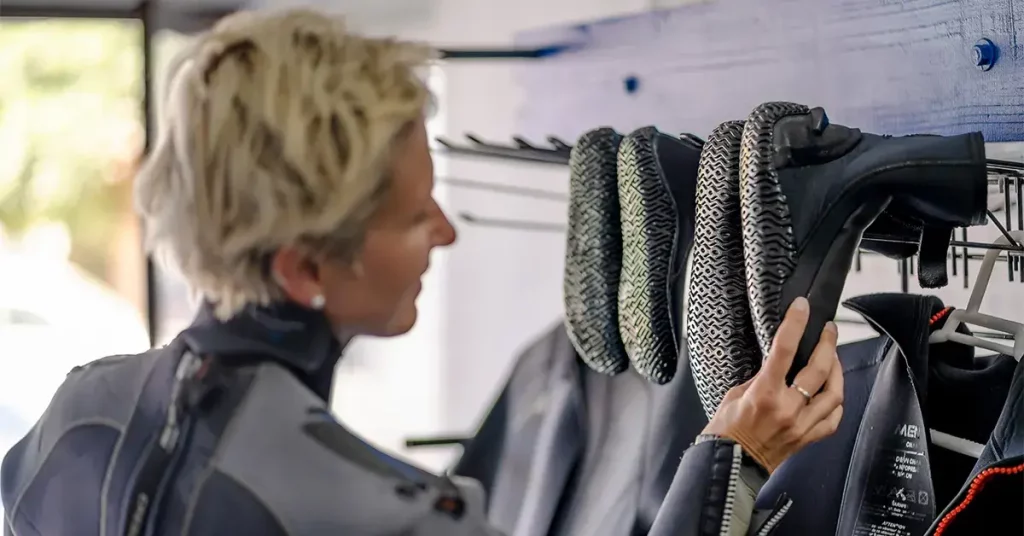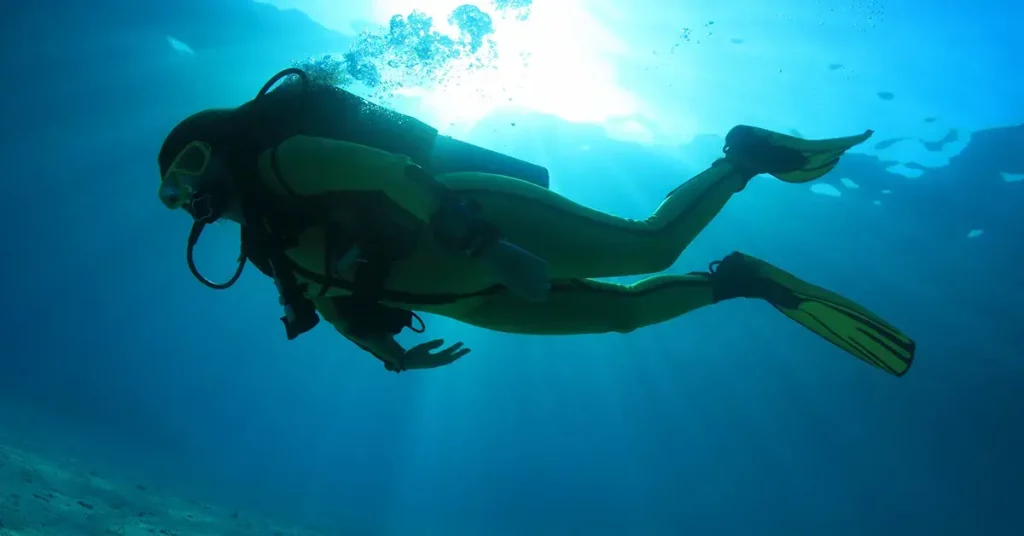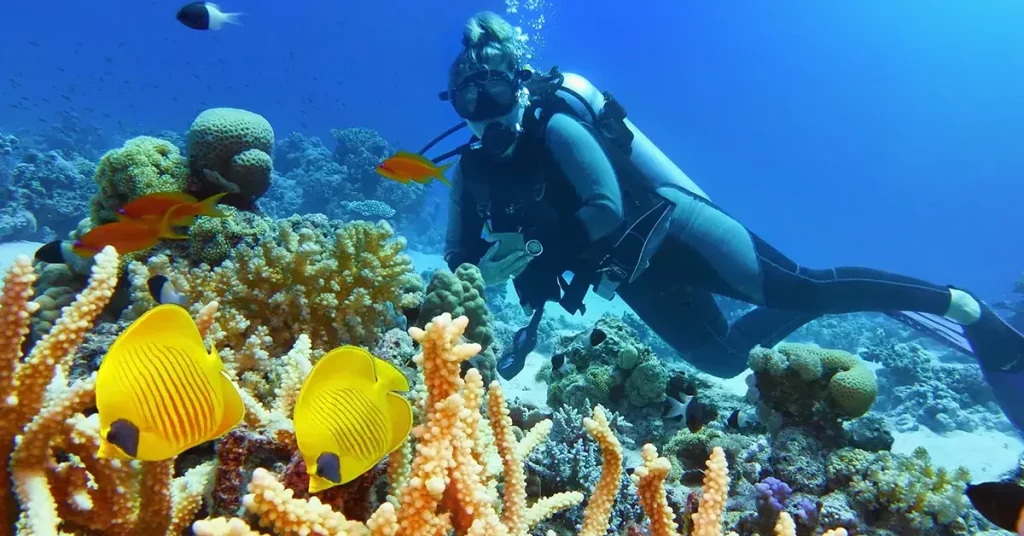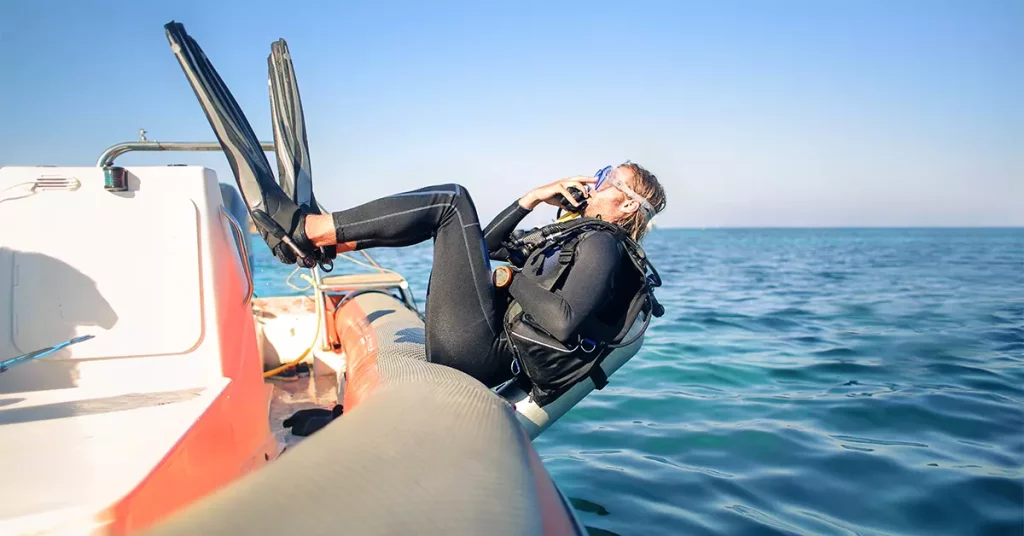Many divers spend hours researching and considering the latest and greatest fins, masks, knives, and wetsuits – but never consider the importance of a good pair of dive boots.
There are few dive items that provide such great value for the price. A good pair of dive boots or socks will cost you less than a decent meal for two but will make your scuba, snorkeling or freediving experience much more comfortable.
If you’ve ever used a pair of fins for a full day (or several days), you know they can get pretty uncomfortable. Your feet can develop sore spots, blisters and eventually you won’t be able to use those fins without letting your feet heal up. Duct tape will work in a pinch, but a much better option is getting yourself a comfortable pair of diving boots.
Quick Answer: 7 Best Dive Boots & Socks
- Best Low Cut Dive Boots: Mares Equator 2mm Dive Boots
- Best Hard Sole Dive Boots: Mares 5mm Trialastic Dive Boot
- Best Cold Water Dive Boots: Cressi Isla Tall Neoprene Boots
- Best Dive Socks: Cressi Palma 3mm ST
- Best Snorkeling Booties: Seavenger Zephyr 3mm Neoprene Socks
- Best Dive Socks for Spearfishing & Freediving: Cressi Anti-Slip Neoprene Socks
- Best Scuba Diving Boots: TUSA Imprex 5mm Dive Boots
Why do you need dive boots
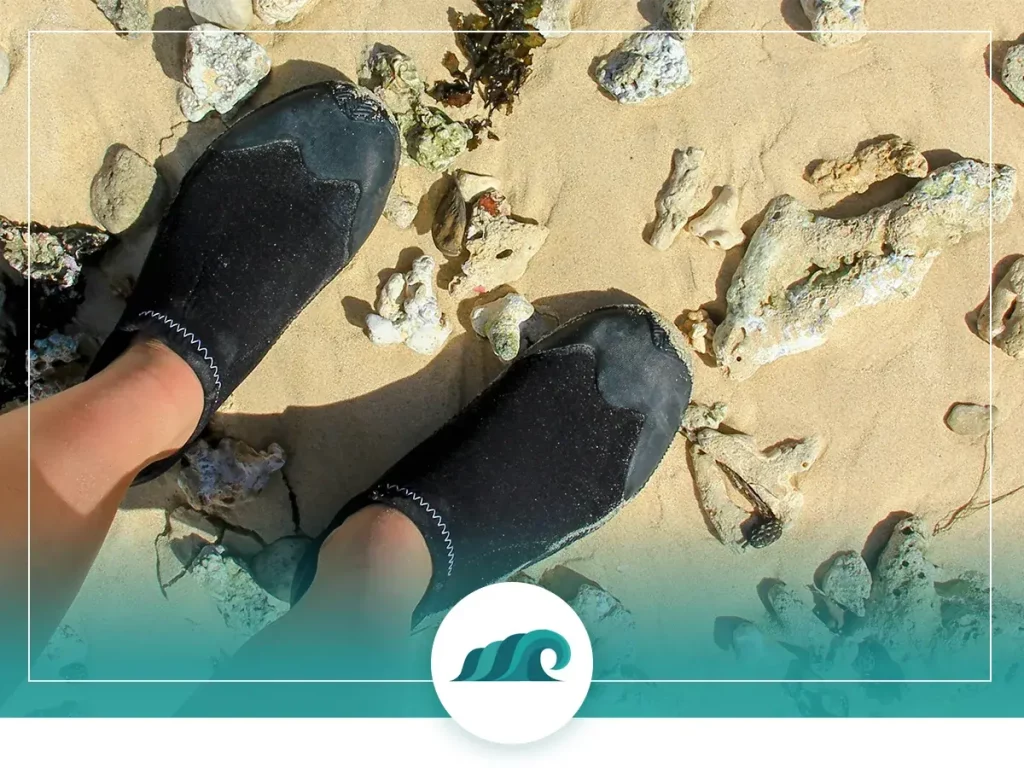
Why do you need dive boots anyway? Surely your feet can handle wearing diving fins without extra protection?
Well, yes and no.
You don’t need diving boots for every diving situation, but they sure come in handy in many ways.
Diving boots are particularly useful for any type of shore diving. They protect the bottom of your feet when walking from the beach or shore into the water. Walking with your fins on can be a major pain, and you don’t want to cut the soles of your feet on jagged rock, coral or glass.
Dive boots are important for cold water diving, as your extremities will get colder than the rest of your body. A pair of 5mm+ dive boots will keep your feet the same temperature as the rest of your body, and allow you to dive comfortably for longer.
Keeping your feet protected is probably the most important feature of dive boots and socks. If you dive a lot, even the best fins can start to rub against your feet and create blisters. The soft neoprene material of dive boots will keep your feet cozy and protected.
Full-thickness dive boots are usually meant to be used with open heel fins. However, if you use closed heel fins, a thinner pair of dive socks will offer many of the same benefits.
Best Low Cut Dive Boots: Mares Equator 2mm Dive Boots
These lightweight rubber-soled boots are great at protecting your feet from sharp rocks, coral, and shells. They’re comfortable, fit just below the ankle, and keep sand from getting inside. The hard rubberized sole is designed to be used with open heel diving fins.
2mm thick neoprene is great for snorkeling, warm water scuba diving, and walking around the beach or shore. The boots are easy to put on and off, as well as to clean. They can be flipped inside out without much effort.
The sizing runs on the larger size, so make sure to order one size down for a good fit.
Key Features
- Lightweight 2mm boots are great for warm weather
- Sturdy, vulcanized rubber soles protect your feet
- Comfortable fit and easy to put on and take off
- 2mm nylon II neoprene
- Vulcanized rubber sole
- Glued and blind stitched
- Protective tall heel
- Color: Black
View Pricing On:
Best Hard Sole Dive Boots: Mares 5mm Trialastic Dive Boot
If you’re after a dive boot with great foot support and thick, substantial soles – then this beefy boot is for you. It’s more like an actual boot than a typical dive bootie and offers serious protection from sharp objects and rocks.
The boot’s rubber tread provides a powerful grip and will allow you to navigate slippery rocks like a pro. The high top design also gives them great thermal insulation and keeps sand and pebbles from getting in.
A heavy-duty, leak-proof zipper makes putting on and taking off these boots a breeze. The upper material is soft and stretchy neoprene, which means excellent power transfer while finning.
One interesting feature is the fin strap lug located on the heel. This keeps your fin strap locked in position, preventing it from slipping off underwater.
Mares includes a 2-year warranty with these dive boots.
Key Features
- Heavy-duty hard soles offer maximum foot protection
- Boot tread offers a powerful non-slip grip
- Upper neoprene material is ultra-soft and stretchy
- Fin strap lug keeps your fin strap from slipping
- 5mm Trilastic dive boot for colder waters
- Comfortable hard sole for control and power
- Rubber sole ensures sure grip
- Zipper dam prevents water seepage
- Toe & heel reinforced with vulcanized rubber
View Pricing On:
Best Cold Water Dive Boots: Cressi Isla Tall Neoprene Boots
These well-made boots by Cressi are ideal for cold water diving. Available in both 5mm and 7mm thicknesses, these boots will keep your feet well insulated even in the coldest water conditions.
The rubber sole is durable and provides a sure grip when traversing over slippery, wet surfaces. It’s not as thick as some other dive boot soles but will provide a decent level of protection.
A heavy-duty zipper encloses the boot around your foot and ankle, with a watertight sealing flap to prevent water seepage. The toe and heel are reinforced with rubber caps – adding extra protection in case you drop heavy gear on your toes.
The heel has a built-in fin strap holder, which helps keep your fin strap from slipping off while finning.
Key Features
- Ideal for cold water environments
- Durable rubber sole provides a sure grip
- Reinforced toe and heel caps offer extra protection
- Cressi is a REAL diving, snorkeling and swimming Italian brand, since 1946.
- Built in sole to provide extra comfort.
- Super elastic Neoprene to provide comfort.
- Thickness of boot provides toughness while maintaining warmth.
- Built in fin strap holder.
- 5mm Neoprene construction
- Built in fi n strap holder
- Built in sole to provide extra comfort
- Super elastic neoprene to provide comfort
- Thickness of boot provides toughness while maintaining war
Prices pulled from the Amazon Product Advertising API on:
Product prices and availability are accurate as of the date/time indicated and are subject to change. Any price and availability information displayed on [relevant Amazon Site(s), as applicable] at the time of purchase will apply to the purchase of this product.
View Pricing On:
Best Dive Socks: Cressi Palma 3mm ST
These lightweight neoprene dive socks are perfect for using inside fins with full foot pockets. They’re low profile, and super easy to slide on and off. They don’t offer the same level of protection as full dive boots but will protect your skin from chaffing and forming blisters.
The bottoms have a durable rubber anti-slip grip, which comes in handy when trying to walk around on a slippery boat deck. The neoprene is super stretchy and comfortable, making your finning experience much more enjoyable.
They’re fairly cheap and weigh next to nothing, so if you’re traveling, buying these boots to throw in your bag is a great option.
Key Features
- Ultra lightweight dive socks perfect for full foot pocket fins
- Non-slip coating sole provides a sure grip
- Can be used for open heel or closed heel fins
- Durable glued-and-sewn seams
- Short socks made with 3mm thick super elastic and ultra durable neoprene & nylon for ensure warmth and comfort. Ideal for snorkeling and scuba diving.
- Grip sole design made with durable rubber: non-slip on wet surfaces such as boat decks and slipper ladders
- The Palma ST socks are great for full foot or open heel fins.
- They are built-to-last with glued-and-sewn seams for strength and durability.
- The Palma ST socks are designed in Italy by Cressi and made in China. Cressi is an Italian brand pioneer in scuba diving, snorkeling and swimming equipment since 1946.
View Pricing On:
Best Snorkeling Booties: Seavenger Zephyr 3mm Neoprene Socks
These snug neoprene socks work great for snorkeling, swimming, scuba diving and walking on the beach. The 3mm thick neoprene provides some warmth, while still being thin enough to slide on and off easily.
Perfect for any sized feet, the sock material is super stretchy and conforms to your foot’s shape. A honeycomb-patterned grippy sole adds traction and keeps you from slipping on wet surfaces. The grip also protects your feet from burning in the hot sand.
They fit perfectly inside both open heel and closed heel fins, and will protect your feet from getting cut up or blistered.
Key Features
- Super stretchy neoprene conforms to your feet
- Honeycomb sole grip provides a sure grip on slippery surfaces
- Great for snorkeling, scuba diving, or any watersports
- CONSERVES BODY HEAT — 3mm neoprene provides insulation for cooler waters.
- SUPER STRETCHY — 4-way stretch material forms to your foot for a comfortable fit.
- RELIABLE DURABILITY — Glued and blindstitched seams minimize water flow and maintain strength.
- MULTI-USE SOCKS — Ideal accessory for snorkeling, diving, water aerobics and other water sports.
- NON-SLIP GRIP — Dotted silkscreen sole keeps you from slipping or falling.
Prices pulled from the Amazon Product Advertising API on:
Product prices and availability are accurate as of the date/time indicated and are subject to change. Any price and availability information displayed on [relevant Amazon Site(s), as applicable] at the time of purchase will apply to the purchase of this product.
Best Dive Socks for Spearfishing and Freediving: Cressi Anti-Slip Neoprene Socks
These soft and supple neoprene socks work well for all kinds of diving but are particularly suited to freediving and spearfishing. The 2.5mm thick neoprene protects your feet from chaffing while being thin enough to allow your feet to move around freely.
The sock interior is coated in Metallite (similar to an open cell wetsuit coating) which increases thermal protection. The neoprene is also very stretchy, so donning and doffing these socks is a breeze.
Protecting the bottom of your feet is a speckled, reinforced anti-slip coating. It increases your grip on slippery surfaces like boat decks or ladders.
Available in black as well as blue camo, brown camo, and technical camo patterns – you can easily match these socks to your wetsuit color.
Key Features
- Soft and supple neoprene is easy to put on and take off
- Metallite lining provides added thermal protection
- Excellent non-slip coating on the bottom
- Available in a variety of camouflage colors
- The Anti-Slip Neoprene socks are single-lined, thin, high stretch neoprene socks that are available in a a variety of patterns.
- The inside is lined with Metallite so they are easy to put on and take off. The sole has an effective non-slip lining.
- They can be used with both closed foot fins for greater warmth and protection from scratches and chafing against the skin, as well as with firm-soled boots, by using open-heel fins.
- The Anti-Slip Neoprene Socks are designed in Italy by Cressi and made in Cambodia. Cressi has been an Italian brand pioneer in scuba diving, snorkeling, and swimming equipment since 1946.
Prices pulled from the Amazon Product Advertising API on:
Product prices and availability are accurate as of the date/time indicated and are subject to change. Any price and availability information displayed on [relevant Amazon Site(s), as applicable] at the time of purchase will apply to the purchase of this product.
View Pricing On:
Best Scuba Diving Boots: TUSA Imprex 5mm Dive Boots
Made by legendary Japanese diving manufacturer TUSA, these boots are great for any type of diving in cooler water. The hard sole protects your feet when walking over rougher terrain, like rocks or coral.
It’s not a full thickness sole though, so it’s still fairly flexible compared to more heavy-duty boots.
A fin retaining cleat on the heel keeps your fin strap from sliding off when finning. On the top of the boot, a glide-skin seal prevents unwanted water from flowing into the boot.
The closure is a heavy duty zipper with a Velcro zip retainer holding the zipper from coming off mid-dive. A reinforced rubber toe and heel section provides added protection in case you happen to drop anything on your feet.
Key Features
- Durable 5mm neoprene good for a variety of diving conditions
- Hard sole protects your feet during shore dives
- High-quality TUSA product
- The watertight glide-skin seal keeps out water
- Injection molded sole with super traction
- 5.0 mm neoprene/nylon jersey
- Sizes: 4-13
- Colors: Black
Prices pulled from the Amazon Product Advertising API on:
Product prices and availability are accurate as of the date/time indicated and are subject to change. Any price and availability information displayed on [relevant Amazon Site(s), as applicable] at the time of purchase will apply to the purchase of this product.
View Pricing On:
How to pick the best dive boots
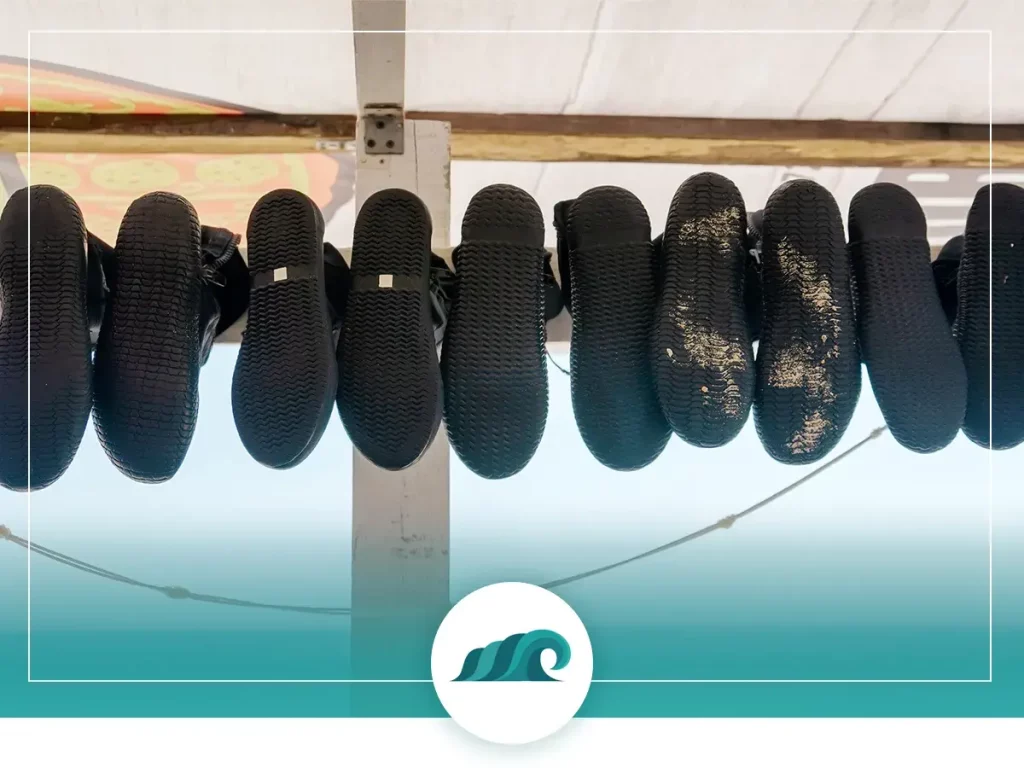
Picking the best dive boots is a lot like picking out a pair of shoes – a lot will depend on your personal preference, foot shape/size and how you plan to use them.
Sole
Sole thickness is one of the most important features to consider in a dive boot.
If you plan on doing any shore diving then the extra protection offered by a thicker sole is worth considering. Thicker soles will keep the sensitive bottoms of your feet from getting cut up by rocks, coral, or poked by urchins.
If you dive from a boat or platform and don’t need to travel over sharp, rocky shoreline, then dive boots or socks with thin soles will work fine. Thinner soles are also more flexible, which makes using your fins easier and more efficient.
If you dive in hot climates, thicker soles will also keep the bottoms of your feet from getting burned by the hot sand.
Material Thickness
The best material thickness for your dive boots will largely depend on the water temperature in the area you plan to dive. Thicker boots offer better thermal protection but are less flexible.
Dive boots work the same way as wetsuits – they trap a thin layer of water between your body and the neoprene material. This water then warms up to the same temperature as your body, trapping in heat.
Most boots come in 2mm, 3mm, 5mm and 7mm thicknesses – similar to wetsuits. 2 to 3mm thickness work well in warmer waters (60°F to 75°F), while 5 to 7mm would keep your feet warm in colder temperatures (50°F to 62°F).
Many divers simply match their dive boot thickness to the thickness of their wetsuit.
High Cut vs. Low Cut
Much like regular socks, diving boots and socks are typically either high cut or low cut. High cut boots enclose your entire ankle, while low cut boots leave your ankle free, but exposed to the elements.
The added ankle support offered by high cut boots are a good choice for scuba divers who need to hump heavy scuba gear around – you don’t want to twist an ankle! The added insulation also means these boots are better for cold water diving.
If you’re diving in warm water, then low cut boots will work well. The freedom offered by low cut boots makes them great for snorkeling, or anyone who prefers more freedom of movement while finning.
Fasteners
There are a few different fastening methods used in most dive boots. The most common are zippers, Velcro, and slip-on.
Mostly found in high cut boots, zippers make putting on and taking off your boots quick and easy. Look for a high-quality zipper that won’t leak or come undone in the water.
Velcro is typically used as an extra closure on boots with zippers. It locks the zipper in place so it won’t come undone by accident. Some Velcro closures also allow you to cinch the boot and adjust the fit according to your preference.
Slip-ons are typically found in lightweight, low-cut dive boots and socks. They’re easy to slip on and off and offer a lower profile than other dive boots.
Size and Fit
Dive boots are typically available in regular shoe sizes. Most will fit true to size, but check the manufacturer’s sizing guide if you have any doubts.
The fit should be similar to a well-fitting sneaker or dress shoe – fitted but not too tight. You don’t want it to be so tight that your toes are bunched up against the front of the boot.
At the same time, you don’t want too much loose space. That could cause your boots to slip or even come off during a backwards roll entry.
Dive boots are typically sold only in full sizes, so if you’re a half size, round up to the next full size. Many are also only available in men’s sizes, so women will need to order a size or two down.
Fin Compatibility
An important consideration when choosing a pair of dive boots is how they’ll fit with your fins on. After all, if they don’t fit well inside your fins, you’ll never wear them!
Make sure to try on your fins and dive boots together before you jump in the water. If possible, bring your fins with you when you try on dive boots or socks.
If you use open heel fins, getting an exact fit is less important. You can always adjust the foot strap around the dive boot. For closed heel fins, opt for slimmer dive socks designed to fit inside the foot pockets.
Scuba Boots vs. Fin Socks
The major difference between scuba dive boots and fin socks is durability and sole thickness.
Scuba boots have thick rubber soles that are designed to protect your feet when you walk over the sharp, rocky shoreline. They’re bulkier than fin socks because they’re built to fit inside the roomier foot pockets of open heel scuba fins.
Fin socks are lighter and slimmer, without rubber soles to protect the bottoms of your feet. If you have to walk over rocky terrain on your way to the water, bring a pair of flip flops to protect your feet.
Fin socks are usually made of neoprene, which is flexible and warm but can get damaged on sharp objects. They’re meant to fit inside fins with closed foot pockets, which are less roomy than open heel fins.
How to take care of your dive booties
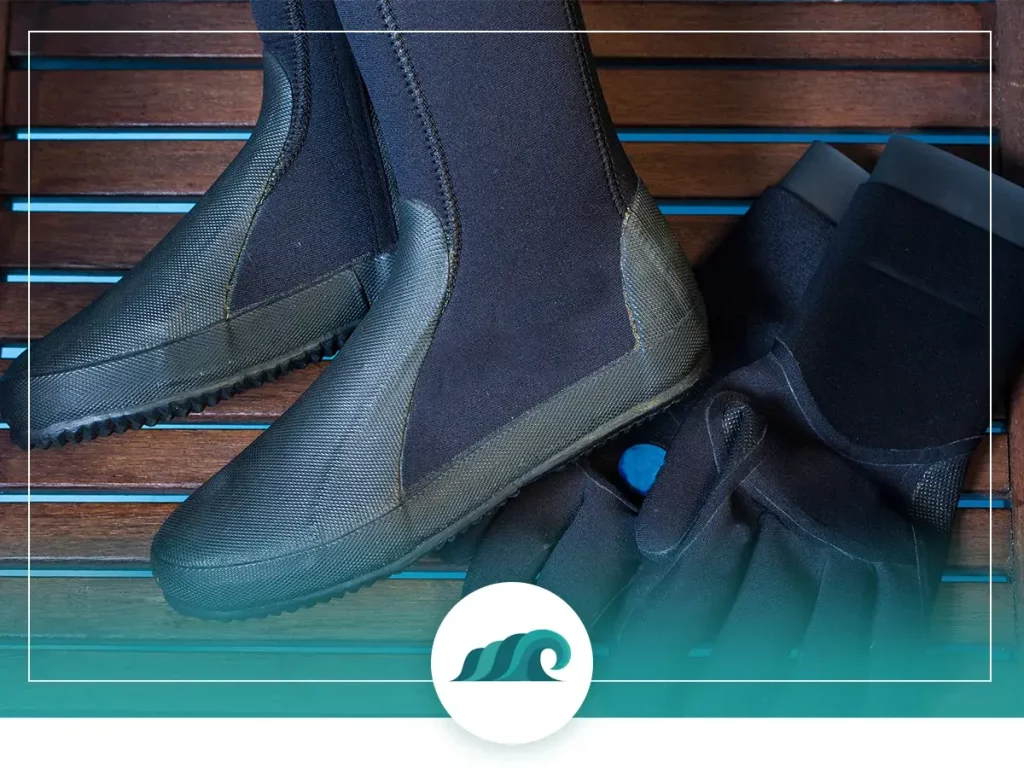
Taking good care of your dive boots will ensure they last as long as possible. Treat them with the same care you would give your wetsuit.
If your boots are on the tighter side, use some wetsuit lubricant or soap to slide them on smoothly. You don’t want to stretch or force the neoprene material excessively.
When you’re finished diving, give them a good rinse in freshwater and wash the inside with a mild, non-irritating soap. Baby shampoo works well for this. Neoprene can develop a nasty smell if not cared for properly, so try not to forget this step.
After cleaning, let the dive booties or socks air-dry and put away in a cool, dry place. Try to keep them out of direct sunlight as it can damage the material. Also, avoid using harsh cleaning chemicals when washing the neoprene material – they can damage the lining and negatively affect its ability to insulate your feet.
Wrapping it All Up
A good pair of diving boots or socks is undoubtedly a key piece of diving gear.
However, it’s usually the last thing most divers think of when considering what gear to buy.
Keeping your feet protected and comfortable while diving will ensure you can dive for hours at a time – without having to stop and rest your sore footsies.
You might not agree, but I’d say dive boots are a key piece of diving safety gear. Cutting open your heel on a sharp rock or piece of coral can really put a damper on your day, and put you out of commission for a while.
When considering which diving boots to buy, the most important things to keep in mind are comfort and use case.
You want boots that are comfortable to wear for many hours (or days) at a time. Everyone’s feet are different, so a boot that’s comfortable for a friend may not be ideal for you. If possible try on boots before you buy them.
Use case means where and how you plan to use your boots (cold vs. warm water, open heel vs. closed heel fins, and shore diving vs. boat diving).

